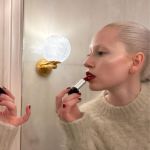
Dark circles are the end-of-summer gift we definitely don't need
A small guide on how to deal with and minimize them, causes and remedies
September 3rd, 2024
The eye contour is a very sensitive and reactive area that tends to show signs easily. The epidermis is thinner, lacking sebaceous glands, and less rich in collagen and elastin. Due to its characteristics, this particular area of the face is more prone to skin imperfections, which can worsen if we adopt an unhealthy lifestyle or do not take proper care with specific treatments. Sleepless nights, periods of stress, long days staring at a screen, an improper diet, or simple genetic predisposition can negatively impact our appearance, exacerbating the signs under our eyes. For some, this manifests as wrinkles or expression lines, but more commonly, as puffiness or dark circles. The result? Our eyes look tired, dull, and less relaxed.
What Are Dark Circles?
We refer to dark circles as those dark halos, compared to the rest of the complexion, that appear in the area under the lower eyelid. The coloration can vary from brown to black, or take on bluish, purplish hues, depending on our skin color and the underlying cause. It is a physiological phenomenon related to the vasodilation of the capillaries under the lower eyelid, affecting both men and women, especially as they age, and can also occur along with puffiness under the eyes.
What Causes Dark Circles?
Facial structure, very thin skin, poor circulation, skin laxity, seasonal allergies, too few hours of sleep, or pre-existing medical conditions are just some of the factors that contribute to darkening the area under the eyes. Here are other common causes:
- Genetic Predisposition: If someone in our family has prominent dark circles, it is likely that we have inherited a tendency to have a darker and sometimes swollen area under the eyes.
- The Natural Aging Process: With age, the skin tends to become lax, thinner, and less hydrated due to decreased sebum production. Skin laxity and dehydration make the dark blood vessels under the skin more visible, creating a shadow.
- Hyperpigmentation: The dark periorbital area is characterized by an overproduction of melanin, due to genetic or environmental factors.
- Allergies: Seasonal allergies and nasal congestion can contribute to poor circulation under the lower eyelid, leading to dilated veins that appear larger and darker.
- Rubbing: The area under the eyes is particularly sensitive, and persistent rubbing can cause a dark halo in the area.
- Dehydration: When the body is not well-hydrated, the skin suffers, including the skin under the eyes, which may appear dull and sunken. Drinking the right amount of water improves circulation and prevents dark circles.
- Smoking, Alcohol, and Diet: Smokers, heavy drinkers, those with an unbalanced diet, and those who drink little water are more prone to dark circles. For example, a deficiency in iron or vitamin B12 can contribute to the formation of shadows under the eyes.
- UV Exposure: Sun damage from years of unprotected exposure also affects the eye contour, causing photoaging and purple dark circles.
- Eye Strain: Spending long days staring at a screen strains the eyes, causing the blood vessels around the eyes to enlarge and become more visible.
- Fatigue: Not getting enough sleep does not cause dark circles but can exacerbate the problem. Severe stress, periods of extreme fatigue, and lack of sleep can negatively impact proper blood circulation in the periorbital area, promoting vasodilation and fluid retention.
How to Reduce Dark Circles?
Dark circles are multifactorial, complex, and, especially if hereditary, it is not possible to eliminate them completely or permanently. However, prevention, specific products, and treatments can make a difference and minimize their appearance. Here are some tips to follow if you want your dark circles to be less noticeable:
- Watch Your Diet: As Paula Begoun, founder of Paula's Choice Skincare, reminds us, a balanced diet rich in vitamins, minerals and nutrients helps improve overall skin health and reduce the appearance of dark circles. Therefore, go for fresh fruits, vegetables, whole grains, lean proteins, and healthy fats. In particular tomatoes, which contain an antioxidant called lycopene that stimulates circulation and protects blood vessels, and other foods such as blueberries, watermelon, oranges, and beets. Finally, it's important to drink the right amount of water.
- Avoid Smoking and Alcohol: We've already mentioned that these are among the causes of dark circles. So, if you can, say goodbye to cigarettes because research has shown that smoking and inhaling secondhand smoke worsens dark circles. Moreover, alcohol dehydrates the skin and impairs circulation, negatively affecting our appearance.
- Get Enough Rest: Lack of sleep doesn't cause dark circles, but sleeping better—between seven and nine hours a night—improves our appearance the next day. A tip: sleeping on your back with your head slightly elevated minimizes the chances of puffy eyes.
- Reduce Stress: Meditation, deep breathing exercises, and yoga can help manage and reduce stress levels, which is one of the causes of dark circles.
- Always Apply Sunscreen: It's essential to prevent hyperpigmentation, and daily broad-spectrum sunscreen with UVA and UVB protection should be applied up to the lash line. It is also advisable to wear sunglasses to protect the periocular area.
- Follow the Right Skincare: Incorporate eye cream into your skincare routine. Opt for products that contain caffeine, tri-peptides, moisturizing ceramides, hyaluronic acid, and vitamin C, which plump, hydrate, and brighten, reducing any spots and discoloration. Apply them with your fingers, gently patting the product and then continue with light circular movements with the ring finger to stimulate circulation.
- Try the Benefits of Ice: Cold helps constrict dilated blood vessels. Therefore, ice globes, masks, and other tools used in ice facial or cold therapy are highly recommended.
- Play with Makeup: Some people choose to emphasize dark circles with specific makeup, while others want to hide them. In this case, use the color-correcting technique: if dark circles are purple, opt for a yellow concealer; if they are bluish, correct them with a peach or apricot concealer; if they are red, contrast them with green; if they tend to be black, apply an orange or red product.
- Try a Specific Treatment: Chemical peels and lasers are often used to treat various pigmentation issues on the face, while microneedling, a skin procedure that involves using small needles to make tiny punctures in the skin, is also very popular. These tiny holes cause skin cells to go into repair mode, lightening dark circles.




























































